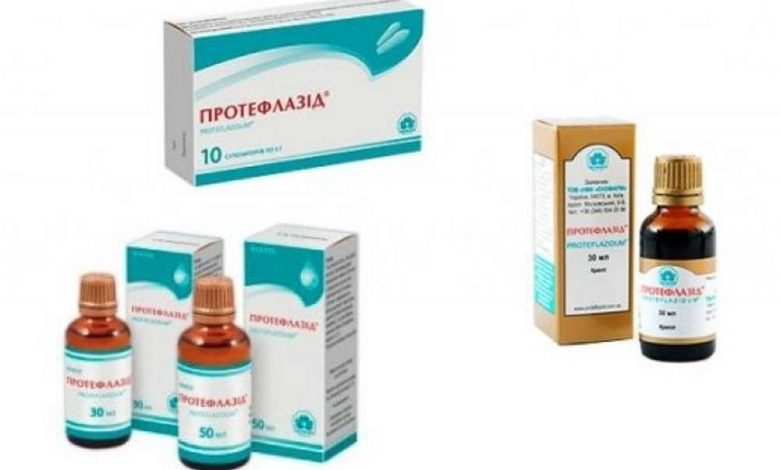Proteflazid: instructions for using the medicine, structure, Contraindications

Active material: Soddy grass pike, reed grass ground
When ATH: J05AX
CCF: Phytopreparation with antiviral action
ICD-10 codes (testimony): A60, B00
When CSF: 09.01.05.04
Manufacturer: NPK Ecopharm Ltd. (Ukraine)
Proteflazid: dosage form, composition and packaging
◊ Solution for topical and oral administration a fluid dark green, and odor; during storage, the formation of a gel structure, collapsing with shaking.
| 100 ml | |
| Soddy grass pike | 50 g |
| reed grass ground | 50 g |
Excipients: ethanol 96%.
25 ml – dark glass bottles with cork-dropper (1) – packs cardboard.
30 ml – dark glass bottles with cork-dropper (1) – packs cardboard.
50 ml – dark glass bottles with cork-dropper (1) – packs cardboard.
Proteflazid: pharmachologic effect
Phytopreparation with antiviral action. Flavonoid glycosides, contained in wild grasses Deschampsia caespitosa L. and Calamagrotis epigeios L., able to suppress the virus-thymidine kinase enzymes and DNA polymerase in cells, Herpes simplex virus-infected (Herpes simplex types 1 and 2). This leads to a reduced ability or complete blocking of viral replication and protein, Consequently, It prevents the growth of virus.
Proteflazid® It stimulates the production of endogenous alpha- and gamma-interferon, which increases non-specific resistance to viral and bacterial infections, It normalizes the immune status of the human body.
Proteflazid: pharmacokinetics
Absorption
Before the drug is absorbed in the stomach and partly followed, primarily, small intestine.
Metabolism and Distribution
A small amount of flavonoids to degrade at “primary passage” through the liver (presystemic metabolism), the main part is distributed in organs and tissues, It penetrates into the virus-infected cells. In uninfected cells, which is not observed increased activity of virus enzymes, preparation practically no effect. It causes suppression enzyme only in infected cells.
Deduction
In adults, the final T1/2 is 5-9 no, which makes use of the drug 3 times / day.
Proteflazid: testimony
- herpesvirus infections of the skin and mucous membranes, herpes simplex virus (Herpes simplex types 1 and 2), including genital herpes.
Proteflazid: dosing regimen
The drug is administered orally and topically.
When using inside the drop is applied to a piece of sugar (or food starch).
To Adult the drug is used according to the scheme: 1 Sunday – by 5 drops 3 times / day; 2-3 Sunday – by 10 drops 3 times / day; 4 Sunday – by 8 drops 3 times / day. Through 1 months after the last administration may if necessary repeat the treatment. The maximum daily dose when administered – 30 drops (1.25 ml or 1015 mg).
Externally applicable preparation in the form of vaginal tampons or lotions to Preparation.
To prepare the vaginal swabs with Proteflazid® necessary 3 ml (72-75 drops) the drug to dissolve in 20 ml saline. Enter the vagina gauze, soaked in the prepared solution. The procedure is repeated 2 times / day. If you experience a burning sensation in the vagina is necessary to double the amount of solvent.
Treatment should be continued until the disappearance of skin lesions or mucous membranes. Maximum treatment – 14 days.
For the preparation of lotions with Proteflazid® necessary 1.5 ml (36-38 drops) the drug to dissolve in 10 ml saline. Gauze soaked in the solution applied to the affected area of skin or mucosa to 3 time / day.
Stopping treatment is the disappearance of the signs of skin lesions or mucous membranes. The maximum rate of treatment should not exceed 14 days.
The maximum daily dose is applied externally 72 drops (3 ml).
Proteflazid: side effects
Usually, the drug is well tolerated.
From the digestive system: nausea, vomiting, diarrhea.
Rarely: allergic reactions, irritation when applied on mucous membranes, transient increase in body temperature to 38 ° C 3-10 day after treatment.
The presence of these symptoms requires correction dose or dosing regimen of the drug.
Proteflazid: Contraindications
- gastric ulcer and duodenal ulcer in the acute stage;
- childhood;
- hypersensitivity to the drug.
FROM caution should be prescribed to patients with severe allergic reactions in the anamnesis.
Proteflazid: Pregnancy and lactation
Application Proteflazid® Pregnancy may only, when the intended benefits to the mother outweighs the potential risk to the fetus. In the appointment during lactation should stop breastfeeding.
Proteflazid: Special instructions
Effects on ability to drive vehicles and management mechanisms
Negative impact on the ability to drive vehicles and management mechanisms have been identified.
Proteflazid: overdose
Cases of overdose have not been described, but perhaps the manifestation of side effects, especially from the gastrointestinal tract.
Treatment: symptomatic therapy.
Proteflazid: drug interaction
The manifestations of the interaction with other drugs not registered.
Proteflazid: terms of dispensing from pharmacies
The drug is released under the prescription.
Proteflazid: terms and conditions of storage
The drug should be stored in the dark, inaccessible to children at temperature from 18 ° to 25 ° C. Shelf life – 3 year.
